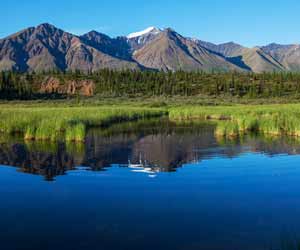Wrangell-St. Elias National Park and Preserve
Wrangell-St. Elias is the largest unit in the National Park System, and it includes the North American continent’s largest collection of glaciers, as well as the second highest peak, Mt. St. Elias.
The park and preserve is about six times as large as Yellowstone National Park – a pretty amazing stat. And it is home to glaciers, rivers, mountains, and remnants of human activity like historic mining sites.
Caribou, moose, and bears roam the coastal spruce forests and lowland bogs, as well as the slopes of Wrangell-St. Elias’s many mountains. Marine mammals dwell sea lions and harbor seals feed along the coastline.
The park is one of few national parks that allow subsistence hunting and fishing, recognizing that these are necessary to the culture and survival of rural Alaskans living in and near the park.
— View Alaska Summer Job Postings —
Getting There and Around
Buses and shuttles run between Anchorage and Glennallen, the largest town near the park. Park headquarters are located in Copper Center, 10 miles south of Glennallen. There are some unpaved gravel roads open to private vehicles within the park and preserve, as well as a number of airstrips open to chartered air taxi.
Activities
Wrangell-St. Elias is a park for wilderness activities – visitors must be self-motivated and enthusiastic about the outdoors. Hiking, backpacking, mountain biking, mountaineering, sea kayaking, and rafting are all popular in summer. NOTE – since these activities are available to tourists it means there are mountaineering jobs, rafting guide jobs, and so forth too!
There are also a variety of air sightseeing (“flightseeing”) operators based out of nearby towns, and air taxis to drop adventurous backpackers in the backcountry.
Weather
With the exception of the coastal Yakutat area, Wrangell-St. Elias experiences a continental interior climate similar to Denali – short summers with variable weather and long, cold winters. Mosquito populations peak during June and July, the warmest months. Summer drizzles are common.
Website: Wrangell-St. Elias


